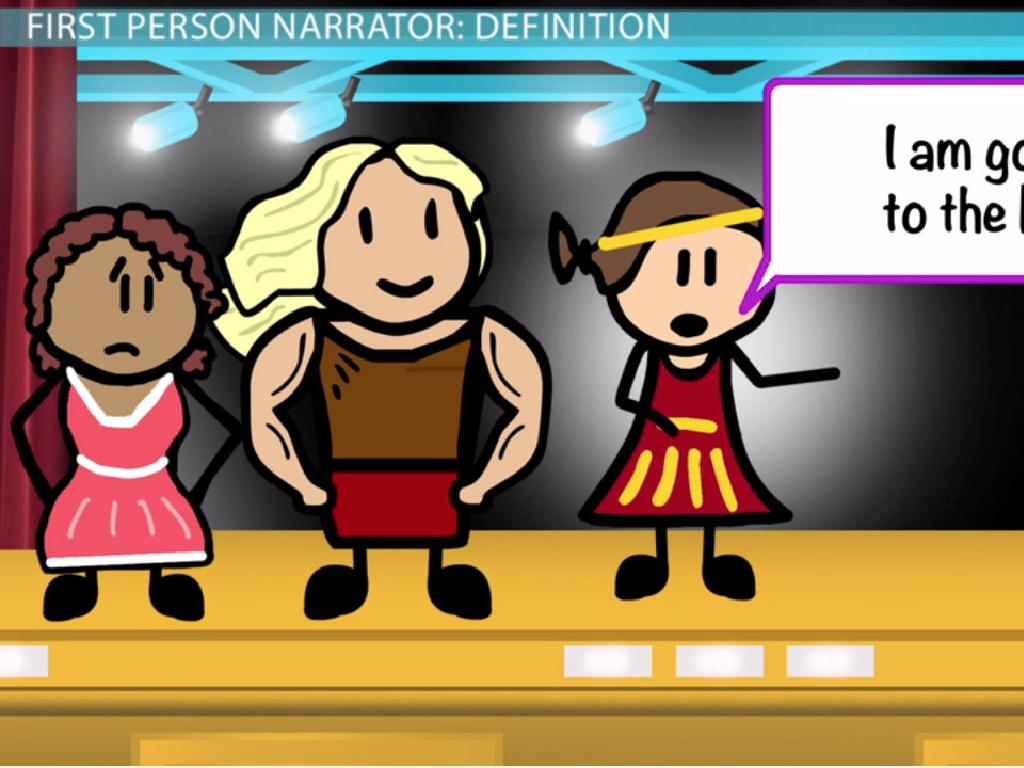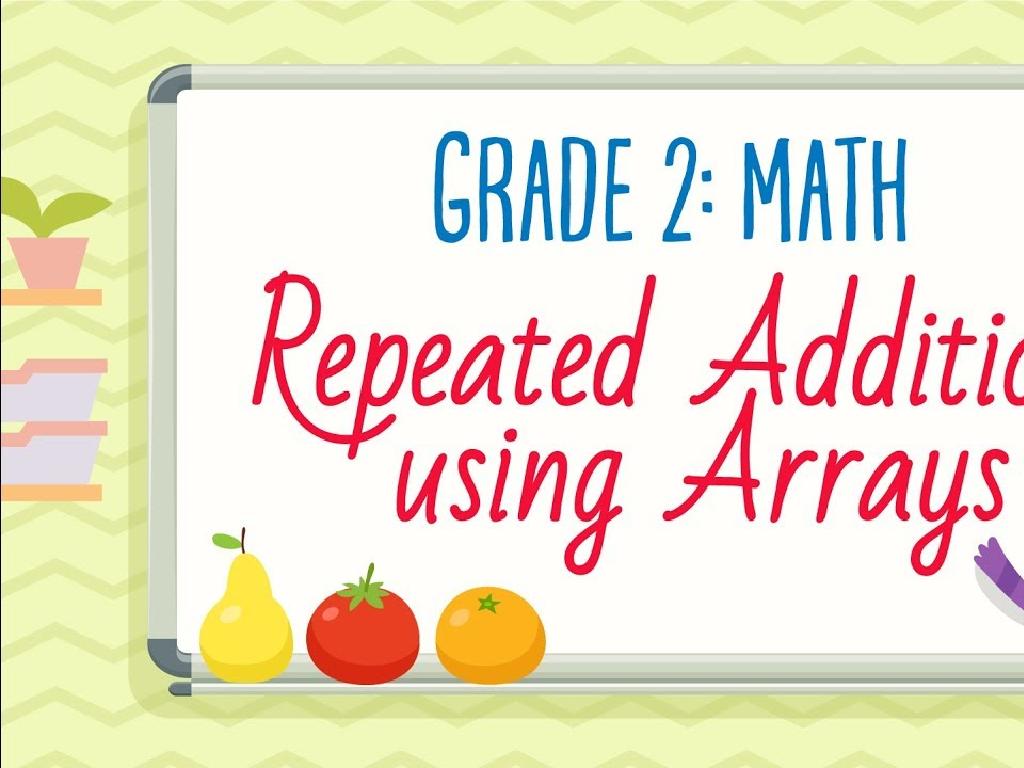Pronoun-Verb Agreement
Subject: Language arts
Grade: Third grade
Topic: Verb Types
Please LOG IN to download the presentation. Access is available to registered users only.
View More Content
Today’s Adventure: Pronoun-Verb Agreement!
– Pronouns & verbs must agree
– ‘He runs’ not ‘He run’. Both need to match in number and tense.
– They work together in sentences
– Pronouns take the place of nouns, verbs show action. They must fit together like puzzle pieces.
– Agreement makes sentences clear
– When they agree, sentences sound right and are easy to understand.
– Let’s learn why it’s important!
– It helps us communicate better and avoid confusion when we talk or write.
|
This slide introduces the concept of pronoun-verb agreement, which is crucial for constructing grammatically correct sentences. Start by explaining that pronouns are words that replace nouns, and verbs are action words. They need to match in number (singular or plural) and tense for the sentence to make sense. Use simple examples to illustrate correct and incorrect agreement. Emphasize the importance of agreement in making our communication clear and effective. Engage the class with examples and ask them to correct sentences with pronoun-verb disagreement to reinforce the lesson.
Understanding Pronoun-Verb Agreement
– What’s a pronoun?
– A word used instead of a noun, like ‘I’, ‘you’, or ‘they’.
– Examples of pronouns
– ‘He’, ‘she’, ‘it’, ‘they’ are all pronouns.
– Pronouns replace nouns
– Just like nouns, pronouns can be subjects in sentences.
– Pronouns & verbs must agree
– They must match in number and tense with the verb.
|
This slide introduces the concept of pronouns and their agreement with verbs, which is a crucial part of sentence construction. Start by explaining what pronouns are and provide common examples. Highlight that pronouns can perform the same functions as nouns, acting as the subject of a sentence. Emphasize the importance of pronoun-verb agreement, meaning that the pronoun and the verb must match in both number (singular or plural) and tense. Use simple sentences to illustrate correct and incorrect agreement, and encourage students to create their own examples. This foundational understanding will help students in constructing grammatically correct sentences.
Understanding Pronoun-Verb Agreement
– Verbs are action words
– Like ‘sing’, ‘dance’, or ‘think’
– They show what the subject does
– ‘He runs’, ‘Birds fly’, ‘Dog barks’
– Examples: ‘run’, ‘jump’, ‘is’, ‘are’
– ‘I am’, ‘You are’, ‘He/She is’
– Pronouns need the right verbs
– ‘He is’ not ‘He are’, ‘They run’ not ‘They runs’
|
This slide introduces the concept of verbs to third-grade students, emphasizing their role as action words in a sentence. It’s crucial to explain that verbs tell us about what the subject, which can be a person, animal, or thing, is doing. Provide clear examples of verbs and use them in simple sentences. Then, transition to pronoun-verb agreement, explaining that pronouns like ‘he’, ‘she’, ‘it’, ‘they’, ‘we’, and ‘you’ must be paired with the correct form of the verb to make sense. Use contrasting examples to highlight common mistakes and correct usage. Encourage students to practice by creating sentences with different pronouns and verbs.
Pronoun-Verb Agreement
– Pronouns & verbs must match
– Both need to agree in number (singular/plural) and person (first/second/third).
– ‘He’ pairs with ‘runs’
– Singular pronoun ‘he’ needs a singular verb ‘runs’.
– ‘They’ goes with ‘run’
– Plural pronoun ‘they’ needs a plural verb ‘run’.
– Practice with examples
|
This slide introduces the concept of pronoun-verb agreement, which is crucial for correct sentence structure. Explain that when we use a singular pronoun like ‘he’, ‘she’, or ‘it’, the verb must also be singular, which often means adding an ‘s’ or ‘es’ (he runs, she watches). Conversely, plural pronouns like ‘we’, ‘you’, or ‘they’ require the base form of the verb without an ‘s’ (they run, you watch). Use examples to illustrate this point and engage the class with practice sentences where they have to choose the correct verb form to match the pronoun.
Singular and Plural Pronouns
– Singular pronouns: he, she, it
– Plural pronouns: they, we
– Matching verbs to pronouns
– ‘He runs’, not ‘He run’. Verbs must agree with their pronouns.
– Practice with examples
– ‘They play’, not ‘They plays’. We’ll do some fun exercises!
|
This slide introduces the concept of pronoun-verb agreement to third graders, focusing on the difference between singular and plural pronouns. It’s crucial to emphasize that verbs change depending on whether the pronoun is singular or plural. For example, with the singular pronoun ‘he’, the verb is ‘runs’, but with the plural pronoun ‘they’, the verb is ‘play’. Use relatable examples and interactive activities to reinforce this concept. Have students come up with their own sentences using singular and plural pronouns, and correct verbs to ensure understanding. This foundational grammar skill will aid in their writing and speaking abilities.
Let’s Practice Pronoun-Verb Agreement!
– Fill in the blanks with correct verbs
– We’ll solve the first few as a team
– I’ll help you start, then you try on your own!
– Match the verb to the pronoun
– Does ‘he runs’ or ‘he run’ sound correct?
– Think before you choose the verb
|
This slide is an interactive class activity to practice pronoun-verb agreement. Start by demonstrating how to fill in the blanks with the correct form of the verb, ensuring it agrees with the pronoun in the sentence. Work through the first few examples together as a class, then allow the students to try the rest independently. Remind them to always consider the pronoun used in the sentence before selecting the verb form. For example, ‘he runs’ is correct because ‘he’ is a singular pronoun and ‘runs’ is the singular form of the verb. Provide guidance and positive feedback as students work through the sentences.
Pronoun-Verb Agreement Examples
– ‘He runs fast’, not ‘He run fast’
– ‘He’ is singular, so we use ‘runs’ to match it
– ‘They play at the park’, not ‘They plays at the park’
– ‘They’ is plural, so the verb ‘play’ doesn’t need an ‘s’
– ‘It is a sunny day’, not ‘It are a sunny day’
– ‘It’ is singular, so we use ‘is’ for one thing: a sunny day
|
This slide provides clear examples of pronoun-verb agreement, which is crucial for constructing grammatically correct sentences. It’s important to explain that verbs must agree in number with the pronouns they accompany. Singular pronouns require singular verbs, while plural pronouns require plural verbs. Use these examples to illustrate common mistakes and correct forms. Encourage students to create their own sentences, ensuring they match the pronouns with the correct form of the verbs. Practice with additional examples as a class to reinforce the concept.
Group Activity: Pronoun-Verb Matching
– Match pronouns with correct verbs
– Use cards to make sentences
– Each card has a pronoun or a verb. Find its pair!
– Share your sentences with the class
– After making sentences, read them aloud to everyone
– Understand pronoun-verb agreement
– This helps us learn how pronouns and verbs work together
|
This group activity is designed to reinforce the concept of pronoun-verb agreement. Divide the class into small groups and provide each group with a set of cards. Some cards will have pronouns and others will have verbs. Students must match the pronouns with the correct form of the verbs to create sentences that make sense. Once the groups have created their sentences, they will take turns sharing them with the class, which will allow for peer learning. As a teacher, facilitate the activity by guiding students who may struggle and ensure that each group understands why certain pronouns match with certain verb forms. Possible activities include matching ‘he’ with ‘runs’ or ‘they’ with ‘sing’ to form correct sentences. This interactive activity not only helps students understand pronoun-verb agreement but also encourages teamwork and communication.
Class Activity: Pronoun-Verb Agreement
– Write sentences with correct agreement
– Pronouns and verbs must match
– ‘He runs’ not ‘He run’
– Share your sentences with the class
– We’ll review them together
– Let’s learn from each other’s sentences!
|
This activity is designed to reinforce the concept of pronoun-verb agreement. Students will practice creating their own sentences, ensuring that the pronouns and verbs agree in number and person. For example, ‘I am’ instead of ‘I is’ or ‘they run’ instead of ‘they runs’. After writing their sentences, students will have the opportunity to share them with the class, providing a platform for peer learning. As a teacher, facilitate the sharing process and correct any mistakes in a constructive manner, explaining why the pronoun and verb must match. Offer praise for correct usage and encourage students to help correct any mistakes they hear, fostering a collaborative learning environment.
Wrapping Up: Pronoun-Verb Agreement
– Congrats on learning pronoun-verb agreement!
– Homework: Finish the pronoun-verb worksheet
– Match the correct verb to each pronoun in the sentences
– Practice is key to mastering this skill!
– The more you practice, the better you’ll get!
– Bring any questions to our next class
– We’ll review any tricky parts together next time
|
Today’s lesson focused on ensuring students understand how pronouns and verbs must agree in number and tense. For homework, students are tasked with completing a worksheet that reinforces this concept by having them match pronouns to the correct verb forms. Emphasize the importance of practice for mastering pronoun-verb agreement. In the next class, allocate time to address any questions and review common mistakes to solidify their understanding. Encourage students to approach the homework with a positive mindset, seeing it as an opportunity to become more confident in their language skills.






